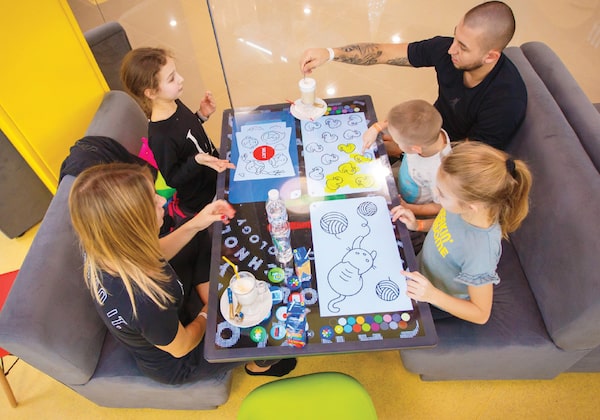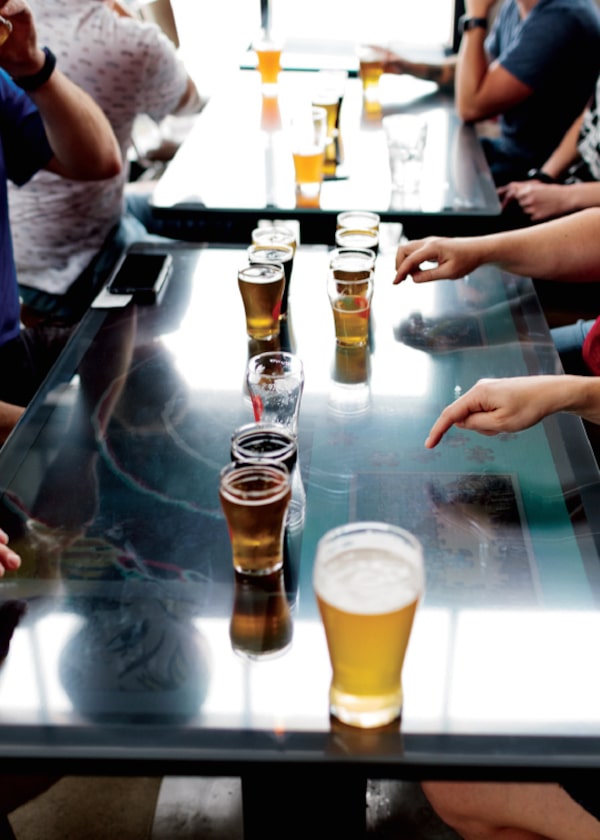
'Smart tables' are one of several technologies changing the restaurant and hospitality industry.
There was nothing unusual about the restaurant I recently took my kids to until our server showed up.
Sun shone in through floor-to-ceiling windows on the busy lunch crowd. There were vinyl records for sale near the entrance, a small ice-cream parlour across from the bar and huge steel vats, part of the in-house brewery, in the far corner. The kind of hip elements you might expect from a restaurant inside a tech hub in Kitchener, Ont.
“Have you been to Graffiti Market before?” our server asked. I told her we hadn’t. “Okay then, I’m just going to give you a quick tutorial about the table,” she said.
Never before have I needed a tutorial on how to use a table. But this was an interactive smart table – essentially a giant iPad. There was an individual display for each of us filled with different apps. Before the brief tutorial had ended, my daughter was already colouring away on a painting app.
There were apps for puzzles, games and one to read the news. The menu app showed pictures and ingredients of every item. We could order lunch with a few taps of our fingers. When we were finished, I could tap the payment app, enter my credit-card information and walk out the door without having to get our server’s attention and wait for her to bring the credit-card machine.
I worried that the entire experience would be cold and impersonal. It turned out to be the best meal out I’ve had with my kids in I can’t even remember how long.
The hospitality industry is undergoing a technology-driven transformation that has already become commonplace in so many other areas of our lives. From banking to buying movie tickets, shopping online to purchasing groceries, we increasingly conduct our business through devices instead of face-to-face interactions with other people. But does tech threaten to take the hospitality out of the hospitality industry? It may, and it’s something we’ll just have to get used to.
“The old standards of service are disappearing,” says Doug Fisher, president of FHG International Inc., a Toronto-based food-service consultancy. “Technology is moving hospitality to a model of efficiency.”

Smart tables can build virtual menus, games and other apps into the dining experience.Handout
Baby boomers and millennials are the two biggest demographics driving changes in the restaurant industry, Fisher says. One of these groups may not like dealing with technology rather than people, but the other is used to it and often even prefers it. “Personally, I don’t like it,” Fisher says. "But my 25-year-old son is happy to order a beer on his phone and have it delivered to him rather than wave down a waitress or a waiter.”
Self-check-in kiosks at hotels and apps that allow people to order and pay at restaurants and bars attract customers who want convenience, Fisher says. But technology also helps cut costs by reducing staff and speeding up the rate at which customers come and go.
Glance Pay, one of the many apps on the market that allows people to pay their bar or restaurant bill on their phones, turns tables over up to 30 per cent faster compared with restaurants that rely on debit card, credit card or cash transactions, says Desmond Griffin, chief executive of the company behind the app.
The company has launched in close to 200 locations, most of which are in Vancouver, and has signed hundreds more that have yet to launch. More than 50,000 people in Vancouver have downloaded the app, with approximately another 10,000 downloads in regions such as Toronto and California.
The appeal of ordering and paying through an app isn’t about cutting out service from the bar and restaurant experience, but reducing the frustrations that come with having to wait for servers, Griffin says.
By eliminating the annoyance of having to flag down a server to order and pay, technology is actually elevating the experience for customers, says Tammy Vaillancourt, a professor in the school of hospitality and tourism management at George Brown College in Toronto.
“In one way, technology is putting the hospitality back into hospitality,” she says. “The service experience can now be focused in on more of the personal elements as opposed to the transactional elements.”
As technology is increasingly becoming part of the hospitality experience, discussions around it have entered the school’s curriculum, Vaillancourt says. One key point of discussion is how technology can influence a customer’s experience at a bar or restaurant, even playing a role in whether or not they chose to come back. “Have you ever dined out and had a wonderful experience, but the area where the organization fell short was that you were waiting forever for your bill?” Vaillancourt says. “It ruins the whole night.”
But Robert Carter, a food-service-industry adviser at market-research company NDP Group, warns that companies in the hospitality industry that rely too much on technology risk alienating customers who want the feeling of being welcomed and cared for – something that personal service and human interaction has traditionally provided.
“You don’t want to get to the point where your product is just a commodity,” Carter says. But he says technology will likely be integrated in some form or another at every level of restaurant. “In the next five years you will absolutely see that consumer-facing technology in the fine dining space.”
At Graffiti Kitchen, my kids certainly had no issue ordering on the table. At lunch, I asked my daughter what she wanted. “I ordered the spaghetti,” she said. Oh, well that was easy. I ordered chicken wings for my son and a chicken sandwich for myself because the picture of it looked delicious.
Our server, Michelle, came by with drinks and cutlery. She asked if we were enjoying ourselves. My kids were too busy playing chess to look up. We played air hockey on the table while we waited for our food. During dessert, we watched a live video feed of chefs plating dishes in the kitchen.
Often, when I take my kids out to eat, there is bickering. They are 10 and 7. They get impatient. They get bored and fight with each other. Sometimes I am reduced to hissing. “Just wait,” I tell them, my face muscles clenched. “We’ll go soon.” This time, there was none of that.
Graffiti Market has 26 smart tables. So far, it is the only restaurant in Canada to feature them. At a cost of $5,000 to $15,000, depending on their size and features, they may be too expensive for many restaurant owners.
“With these tables, the benefit we’ve found is that our servers can actually provide another level of customer service,” says Neil Huber, co-owner of Ignite Restaurant Group, the company that owns Graffiti Market.
When our meal was finished, I tapped the table to pay. It brought up a screen showing what each seat had ordered. There was an option to split the bill. I couldn’t pay because of a glitch, so Michelle brought our bill. She had drawn a smiley face on it. It was a nice touch, but unnecessary. I tipped generously.
We stood up to go, and I noticed most of the old school tables were empty. Michelle waved to us as we left. And before we even got to the car my kids asked when we were coming back.
Live your best. We have a daily Life & Arts newsletter, providing you with our latest stories on health, travel, food and culture. Sign up today.
 Dave McGinn
Dave McGinn